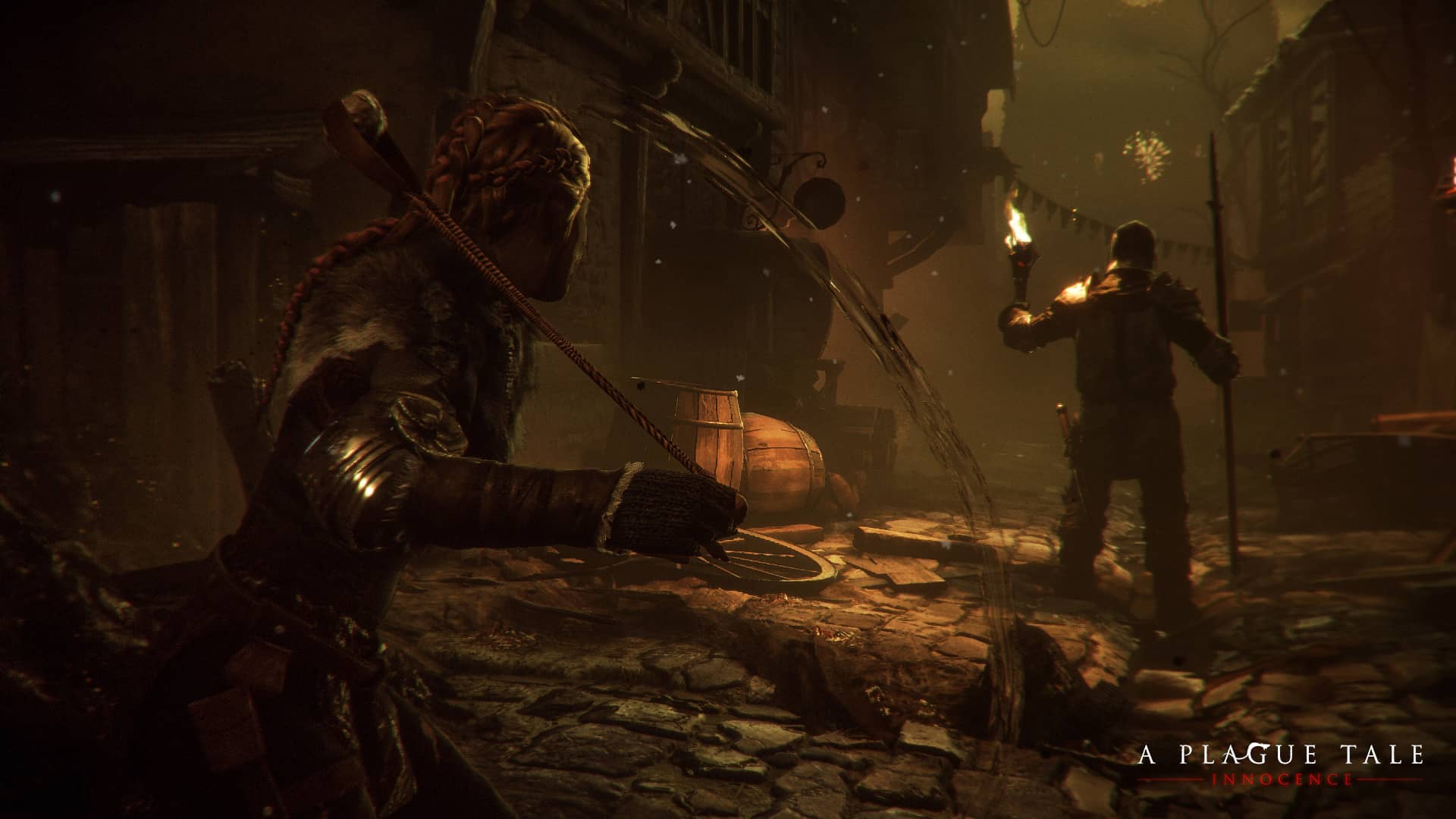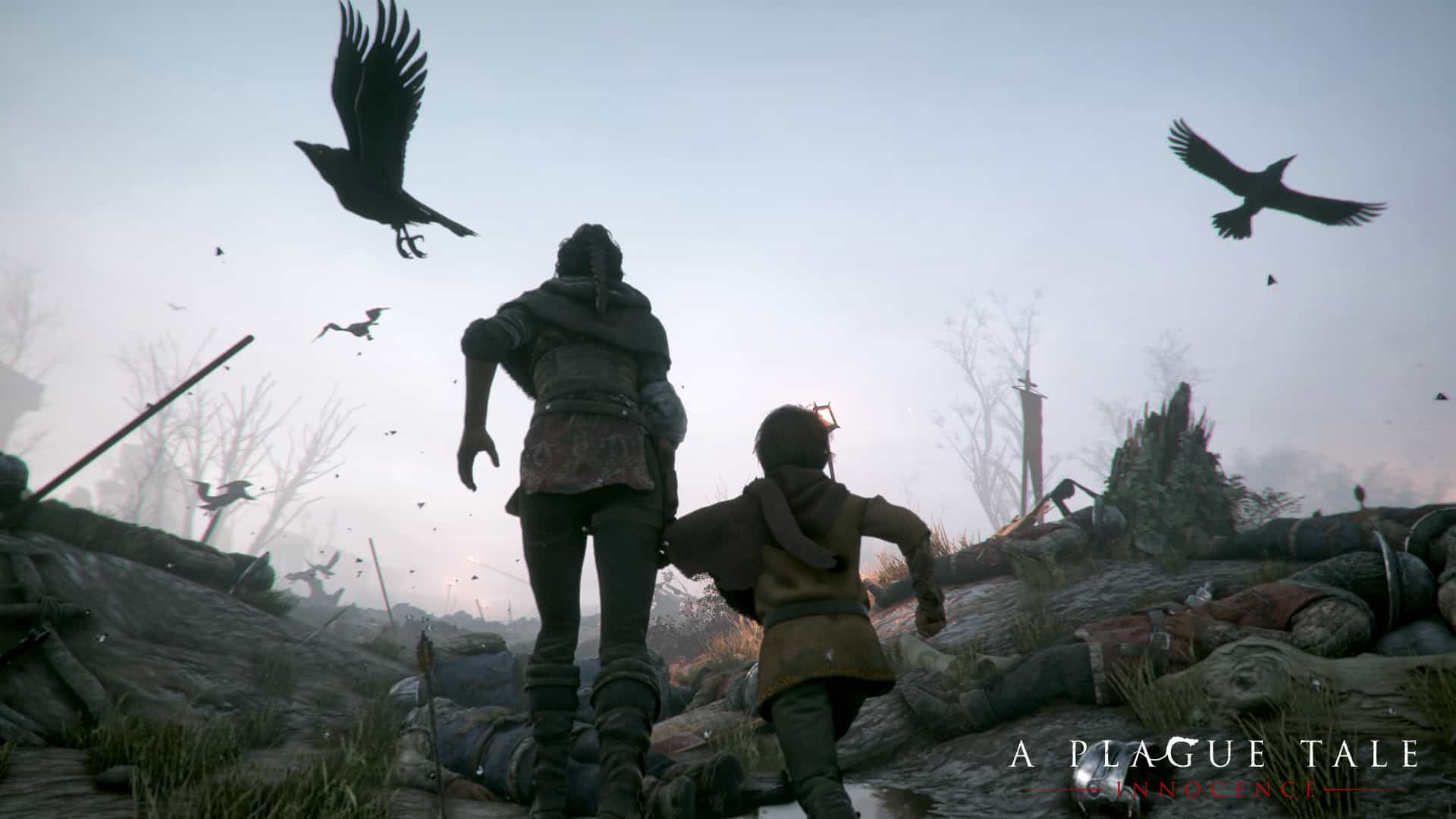Platforms:
Xbox One, PS4, PC
Released:
May 14, 2019
Publisher:
Focus Home Interactive
Developer:
Asobo Studio
There’s a moment early on in A Plague Tale: Innocence where the teenage protagonist Amicia is separated from her little brother Hugo. They have no choice but to take two different paths to get to the same destination. Up until this point, Hugo was too scared to move unless he was holding his sister’s hand, but this time, she has to let him go on his own. Hugo reluctantly goes on ahead, while I, as Amicia, solve an environmental puzzle to find another way.
As I sneak down a flight of stairs, looking out for enemy soldiers, Amicia hears a scream from another room. It’s Hugo. There’s no cutscene, I’m still in control – Amicia starts sprinting towards her brother because that’s what I want to do. I run past a room full of valuable crafting ingredients, because Amicia doesn’t care right now, because I don’t care. Hugo is more important.
Eventually, she finds him. He’s safe. He just saw some rats and got scared. Amicia sighs. As I clear a path to reach him, she mutters to herself under her breath. “Calm down, Amicia… He’s fine, you’re fine… Stay focused.”
In just a few minutes, the game believably portrays one of the many anxieties that come with taking care of a loved one; being in charge of another person’s safety and health while struggling to ensure your own. It’s one thing that this is a topic rarely covered in this industry, but developer Asobo Studio went one step further and made it the thematic base for their entire game, and it pays off. A Plague Tale: Innocence is stressful, horrifically violent, and emotionally harrowing, but it’s ultimately about love, family, and the bond between siblings. Also, thousands of rats.
Set in Medieval France, this part-stealth, part-puzzle game follows Amicia and Hugo on the run from vicious armoured men calling themselves the Inquisition. Without spoiling the story, the siblings are soon alone and confused in a dangerous world: the Inquisition are always right behind them, there’s a mysterious plague affecting the country, and the rats that carry it swarm the streets at night and devour whatever gets near them. With a few notable exceptions, each of the game’s 16 chapters consists of Amicia and Hugo (and occasionally other characters they’ll meet along the way) coming up against either soldiers, rats, or some combination of the two.
The rats are easily the most visually impressive part of A Plague Tale. In each squeaking horde you encounter, you can make out each individual rat, squirming around and on top of each other, like hairy black spaghetti. They have a strong aversion to light and fire, so dealing with them involves getting to the nearest light source to keep them at bay, or creating a light source yourself. These are mostly puzzle sections, and while gross, they often provide a respite from the fast-paced levels. Slowly walking through the rats while holding a torch, watching the spaghetti split apart where the light shines and merge together again is always disgusting and satisfying in equal measure.

Amicia doesn’t use any weapons apart from her slingshot, so stealth sections usually have her throwing rocks to distract soldiers, letting her sneak past. In later levels the game lets you craft one-time-use items, out of ingredients you find in nooks and crannies, to help you take down enemies, but that slingshot remains Amicia’s most reliable tool for the entire game.
Those same ingredients can be used to upgrade Amicia’s equipment at crafting tables (increase how much ammo she can hold, lets her reload her sling faster, etc), so there’s a give-and-take between choosing to immediately craft items you can use against enemies, or to save up to get upgrades that can make your life easier later on. Thankfully, there are only a handful of upgrades available to you, each one making a substantial difference to gameplay, and the game usually gives you the ingredients you need to craft an item if a story section requires you to use one.
Amicia isn’t a fighter. She doesn’t have any combat experience, and she doesn’t have a health bar. If she gets hit once, she’s dead. While that may sound frustrating (and it may take some getting used to for someone accustomed to stealth games featuring sturdier protagonists), it’s a fantastic way to highlight both the character’s vulnerability and intelligence, and the game does a mostly good job placing checkpoints between encounters, so even if you die, you don’t lose too much of progress.
The fact that you’re holding Hugo’s hand throughout these encounters further heightens the tension. An early tutorial introduces a mechanic where you can instruct Hugo to wait at a hiding spot so you can clear the room yourself, but, disappointingly, I never felt the need to use this. Were it more useful, it could’ve been a great way to put pressure on the player, but the game never penalised me for taking Hugo with me the whole way through a level (barring a few mandatory points in the story), nor did I notice any drawbacks to doing so, so the mechanic seems a bit underutilised.
“Between the crafting ingredients and the spaghetti rats, this game made me cry.”
And while I described the checkpointing as mostly good, there are a handful of sections where it made me repeat stuff I wish I didn’t need to. I started a certain area in the final chapter by solving a small optional puzzle and scrounging for nearby ingredients before… let’s just say, a difficult situation. I died, and the game reloaded me to the point I entered the area, meaning I had to solve the puzzle and pick up the ingredients all over again. Then I died again. And again. I wish the checkpointing was a little more cognizant of collectables and ingredients, but I also realise this is a relatively minor quibble to have.

For a world that’s endlessly grim and oppressive, it sure does look good doing it, because the graphics and art design are gorgeous. A Plague Tale ekes every bit of colour it can out of the environment, be it the treetops and bushes during the day, or the fires and half-eaten corpses at night. Amicia and Hugo, as well as the other major characters, have detailed faces, which may not be as expressive as those found in other major AAA releases, but they’re more than enough to make every single emotional moment land. There were several times where Hugo gently hugging Amicia was enough to make my eyes well up. Between the crafting ingredients and the spaghetti rats, this game made me cry.
The youngsters in the English voice cast are also stellar, particularly Charlotte McBurney as Amicia and Tabitha Rubens as Melie. There are also French and German voice options available, which I only mention because the game is set in France and made by a French developer, so it might be a more authentic experience. #subsordubs
A Plague Tale: Innocence is a very tight stealth/puzzle game set in a period of history that was brutal, unfair, and frequently repulsively gory (if you’re in any way sensitive to seeing fictional dead bodies in games – human or animal – please be careful playing this), but that’s not what the game is about. It’s about a young girl doing everything in her power to keep her brother safe, and Asobo Studio smartly anchors each and every chapter and scene of the game with the weight of her struggle. Amicia and Hugo’s relationship is the reason I was invested in A Plague Tale’s plot, even as it started to take off in some offbeat directions towards the end.
Positive:
- Amicia and Hugo are so relatable, I want to adopt them
- The game is stressful, but not too stressful
- The rats are gross and beautiful and gross
Negative:
- The checkpointing occasionally makes you repeat mundane tasks
- The violence in the game is effective, but may not be for everyone
- The overarching plot isn't as interesting as the characters
There needs to be more games like A Plague Tale: Innocence. Asobo Studio have created a brand new IP that confidently prioritises characters and emotions over world-building and lore, to its benefit. As mentioned, the checkpoints could be a little more helpful in a couple of areas and some of the mechanics seemed unnecessary, but none of that stopped me from becoming completely invested in the the tale of Amicia, Hugo, and honestly, even the rats.











